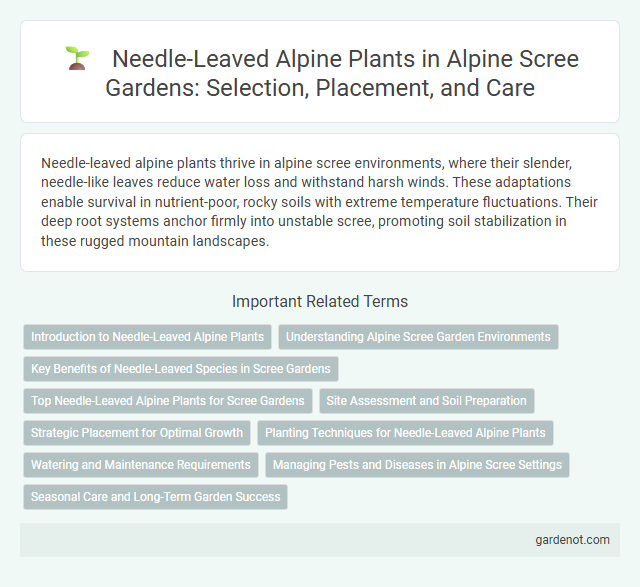Needle-leaved alpine plants thrive in alpine scree environments, where their slender, needle-like leaves reduce water loss and withstand harsh winds. These adaptations enable survival in nutrient-poor, rocky soils with extreme temperature fluctuations. Their deep root systems anchor firmly into unstable scree, promoting soil stabilization in these rugged mountain landscapes.
Introduction to Needle-Leaved Alpine Plants
Needle-leaved alpine plants thrive in harsh scree environments characterized by rocky, unstable slopes and minimal soil. Their narrow, needle-like leaves reduce water loss and withstand extreme cold, enhancing survival in alpine conditions. These adaptations enable them to dominate niches where other vegetation struggles to establish.
Understanding Alpine Scree Garden Environments
Needle-leaved alpine plants thrive in alpine scree gardens due to their adaptation to well-drained, nutrient-poor soils and extreme temperature fluctuations. Their deep, fibrous root systems anchor firmly in loose rocky substrates, enabling stability and moisture absorption in harsh environments. These plants contribute to soil formation and microhabitat creation, supporting biodiversity within alpine scree ecosystems.
Key Benefits of Needle-Leaved Species in Scree Gardens
Needle-leaved alpine species in scree gardens offer exceptional drought tolerance due to their reduced leaf surface area, minimizing water loss in harsh mountain environments. Their dense, needle-like foliage provides effective soil stabilization, preventing erosion on loose scree slopes. These plants also enhance biodiversity by supporting specialized alpine pollinators adapted to high-elevation habitats.
Top Needle-Leaved Alpine Plants for Scree Gardens
Top needle-leaved alpine plants for scree gardens include species such as Pinus mugo, Juniperus communis, and Saxifraga oppositifolia, which thrive in well-drained, rocky environments. These plants exhibit exceptional drought tolerance, compact growth habits, and needle-like foliage that reduce water loss and protect against harsh alpine conditions. Their ability to stabilize scree slopes and provide year-round interest makes them ideal choices for enhancing biodiversity and aesthetic appeal in alpine rock gardens.
Site Assessment and Soil Preparation
Needle-leaved alpine plants thrive in well-drained, nutrient-poor soils characteristic of alpine scree environments. Site assessment should evaluate soil texture, pH levels ranging from 4.5 to 6.5, and organic matter content below 5% to mimic natural conditions. Soil preparation involves minimal disturbance, incorporating coarse sand or gravel to enhance drainage and prevent root rot in these drought-tolerant species.
Strategic Placement for Optimal Growth
Needle-leaved alpine plants thrive on alpine scree due to their strategic root placement that anchors them securely in loose, rocky substrates while maximizing nutrient absorption. Their slender needle-like leaves reduce water loss and withstand harsh, windy conditions typical of high-altitude scree slopes. Optimal growth occurs where these plants exploit microhabitats with adequate sunlight and drainage, ensuring survival in nutrient-poor alpine environments.
Planting Techniques for Needle-Leaved Alpine Plants
Planting needle-leaved alpine plants on scree requires well-draining, gritty soil to mimic their natural mountainous habitat and prevent root rot. Position plants in areas with ample sunlight and protect them from excessive moisture by using raised beds or rock crevices to enhance drainage. Incorporating organic matter sparingly supports nutrient retention while maintaining the soil structure essential for these drought-tolerant species.
Watering and Maintenance Requirements
Needle-leaved alpine plants thrive in well-drained, rocky soils with minimal watering, making them ideal for xeriscaping in alpine scree environments. These species require infrequent irrigation, typically needing moisture only during prolonged dry spells to prevent root rot. Regular maintenance involves removing debris and monitoring for pests, ensuring optimal growth without excessive nutrient supplementation.
Managing Pests and Diseases in Alpine Scree Settings
Needle-leaved alpine plants in scree environments require targeted pest and disease management due to their susceptibility to fungal infections and insect infestations such as aphids and spider mites. Implementing integrated pest management (IPM) strategies, including regular monitoring, biological controls like predatory insects, and the use of eco-friendly fungicides, helps maintain plant health without disturbing the fragile alpine ecosystem. Maintaining proper drainage and avoiding overwatering reduces the risk of root rot and other moisture-related diseases common in alpine scree habitats.
Seasonal Care and Long-Term Garden Success
Needle-leaved alpine plants thrive in well-drained, rocky soil typical of alpine scree environments and require minimal watering during their dormant season to prevent root rot. Regularly removing debris and dead foliage supports healthy growth and reduces disease risk throughout the growing season. Applying a balanced, slow-release fertilizer in early spring promotes long-term garden success by enhancing nutrient availability tailored to the specific needs of alpine scree habitats.
Needle-leaved alpine Infographic

 gardenot.com
gardenot.com